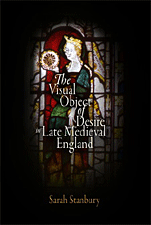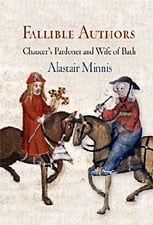Two recent essays on Chaucer’s possible use of the Wycliffite Bible. Amanda Holton, in “Which Bible did Chaucer Use?: The Biblical Tragedies in the Monk’s Tale”, argues that Chaucer did not, at least for the Monk’s Tale, in part because current accepted dates for the completion of the Bible and the Tale mean that it would not have been available for Chaucer to use. Craig Fehrman, in a much more extended 2007 essay “Did Chaucer read the Wycliffite Bible?”, argues that the WB should be considered at least an analogue if not a source for some tales. This is because he was interested in the issues of translation at stake, and a comparison of text in the Parson’s Tale–which is believed to have been finished after the LV–with the LV shows significant similarities.
Karma Lochrie, in Heterosyncrasies: Female Sexuality when Normal Wasn’t (2006), considers the Prioress. The beginning of her chapter entitled “Far from Heaven: Nuns, Prioresses, and Lollard Anxieties” has been noted under a previous post on Lollardy and Gender; these notes build upon that post. “The Prioress,” Lochrie argues, “might have stepped right out of the Lollard imagination, as least as that imagination is provided an outlet in the eleventh conclusion,” which envisioned chastity as repressive (60). Lochrie continues to argue that “Chaucer’s portrait of the Prioress exhibits an uncanny awareness of the eleventh conclusion.” This chapter, then, is one of a series of critical studies which have argued that Chaucer wove knowledge of Lollard critiques into his tales. “What kind of tale would a nun from the Lollard eleventh conclusion tell? One, a Lollard might reply, that reflected the infirmity of her nature and the extremities of which unchecked femininity is capable” (66).

Andrew Cole’s Literature and Heresy in the Age of Chaucer (2007) is an important book which presents not just a consideration of the relationship between Wycliffism and literature but also of the origins of “lollardy” itself. Maybe the best way into this book is to get at one of its central, and polemical, points: contrary to modern critical usage (at least since Hudson’s 1988 The Premature Reformation) Cole argues that “lollardy” should not be conflated with “Wycliffism” because the term “lollardy” is too deeply embedded in a web of contemporary conflicts (theological, literary, lexical, political) to be anything more than confusing in modern critical discourse. The center of his argument is that “lollardy” existed because, essentially, the Church created it. Cole spends much time reconsidering the spring and summer of 1382, including the events at Oxford and the London Blackfriar’s Council, to demonstrate how this was so. He also considers the various versions of Piers Plowman to show how Langland’s use of “lollere”/”lollare” takes part in the “invention” and “reinvention” of “lollardy” during the 1380s. In Cole’s narrative the term moved historically from a B-Text oddity, to be identified as a marginalized heresy by the church in the mid-1380s, to then be revised in the C-Text as commentary “to show that ‘lollardy’ is a construct–an utterance with a politically hostile valence that must be carefully weighed and, if need be, redirected against persons who are thought to be materially or economically unproductive, wasters and friars” (44), and finally to be re-used in the 1390s as the events of the 1380s were rewritten to serve the goals of the church hierarchy or its opponents. If “lollardy” is such a complex construction, a creation of the ecclesiastical powers-that-be whose deployment is then commented on by contemporaries, Cole argues that “the term ‘Wycliffite’ is significantly freer of the baggage that goes with ‘lollard'” (73).
All of these debates mean that the term carries with it a much wider range of meaning than the Church’s polemic would have us believe, and contemporary writers advantage of this. Chaucer becomes a crux in Cole’s argument between the “invention” and “reinvention” of “lollardy” and those who come after–Hoccleve, Lydgate, and Kempe–analysis of whose writings comprises the latter half of the book. Cole’s extended discussion of the “Man of Law’s Epilogue” and the Astrolabe shows that contemporary commentary on the term is significantly more subtle than we have understood it to be. Because we too often equate “lollardy” and “Wycliffism,” we believe “lollardy” = “heterodox/heretic”–but this is to buy into the church’s condemnation of the movement, and to miss the space between these polarities which the term in fact opens up that contemporaries use to explore religious belief. Hoccleve and Lydgate are not the apologists for political and theological belief which we might take them to be. If Kempe is not a heretic, but is a “lollard” to her contemporaries, “then what does she stand to gain from being misrecognized as one?” (159).

Two other recent books present significant full-length studies of Wyclif, Wycliffite thought, and Chaucer. The first is Sarah Stanbury’s The Visual Object of Desire in Late Medieval England (2008). Stanbury discusses ways in which the later fourteenth century commented on (or avoided) the possibilities and hazards of images. Lollard dislike of images becomes a way to present the stakes over what images might represent (another is the Despenser Retable). Her argument connects briefly with, for instance, Jessica Brantley’s brief discussion of Wycliffite critique of images in Reading in the Wilderness ch. 1: “the anti-theatrical, potentially Lollard Tretise of Miraclis Pleyinge uses the metaphor of the play as a ‘living book’ to discuss both the possibilities and the hazards of dramatic representation” (8). Stanbury analyzes Knighton’s story about two Lollards, Smith and Waytestathe, who dismember and burn a wooden statue of St. Katherine, to show that their “iconophobia” is conflated with a misogynistic fear of female saints and a hatred of idols (see 42-43).
After two opening chapters, Stanbury moves to a discussion of Chaucer’s images, with discussions of the Knight’s Tale, the Legend of Good Women, the Pardoner’s Tale, and chapters on the Clerk’s and Prioress’s Tales. “To what extent,” she asks, “is Chaucer’s descriptive practice contoured by a contemporary culture of visual affective piety—and specifically by a discourse with increasingly high ethical and political stakes about the uses of sculpted and painted devotional images?” (101). Chaucer seems not to describe “popular devotional forms” and restricts ekphrasis entirely to pagan images, such as in the KnT (15), in which cases he does imbue devotional images with “vivacity, bringing them to life” (120). In PardT and LGW he uses discourse which implies his awareness of current debates over images. Mostly, though, Chaucer “may have responded to the image debate mostly by a practical strategy of avoidance” (15). Discussions of the Clerk’s and Prioress’s Tales comment on how the plain speaking of Griselda and the Prioress’s liturgical piety subtly draw on image debates. In the last section of the book, Stanbury considers images of Christ, in chapters about Nicholas Love and Margery Kempe.

The second is Alastair Minnis’s Fallible Authors: Chaucer’s Pardoner and Wife of Bath (2008). Minnis’s focus is not an evaluation of heresy, but Wyclif’s thought lies close to the heart of his argument. The context for Minnis’s argument is Donatism, the belief, declared heretical in 411, that a priest in a state of mortal sin could not effectively perform his sacramental duties. Wyclif, Minnis argues, “fell into a version of that heresy—or, at least, was accused of having done so (xiv). Questions which descend from this idea appear in Chaucer. Can a fallible author present a text with any claim to truth? Can woman, or a self-declared “exceptionally ‘vicious man,’” reliably present a moral tale? (6).
The presence of Donatism in the writings of Wyclif and his followers is not, as Minnis notes, entirely consistent. Yet it did surface, with two ramifications. The first, more familiar concern is whether a priest’s administration of sacraments could be efficacious. The second concerns dominion: “According to Wyclif, dominium meant divine right of possession: the right to hold power, whether spiritual or secular, depended on grace. No pope, bishop, or king had true dominion over his subordinates while he lived in a state of mortal sin” (21). One ramification of both of these is the other side of Donatism: can someone—even, perhaps, a woman!—who is in a state of grace be a priest, or hold dominion over others? (24).
As Minnis says, “the fact that Chaucer was interested in such issues need not mean that he advocated them in some distinctively Lollard form” (xv). The reason why they make an interesting context for the study of Chaucer, Minnis claims, is that, in general, “Chaucer was fascinated by ideas which, during his lifetime, became more and more dangerous to discuss” (xv). More specifically, he says of the Donatist anxiety about the “carefully demarcated qualities of the office and the qualities of the man” that “Lollard theology brought [these ideas] together with a vengeance” during his lifetime (19). It could not have been ignored, and the vocabulary provided by Wycliffite thought provides a primary vehicle for the expression of these anxieties. His claim resonates with Cole’s, who concludes his study with a similar statement:
“Wycliffism is . . . part of the processes of cultural negotiation itself, an emergent fund of ideas, forms, rhetorics . . . . When Chaucer thinks of vernacular translation, he thinks of Wycliffism. When Hoccleve and Lydgate apply their topically inflected forms of writing to religious and ecclesiastical issues, they again think of Wycliffism. When Langland and Kempe assess the viability of new forms of religiosity, they, too, think of Wycliffism and the generative debates about ‘lollardy’ that appear to go to the core of their figured authorial identities” (186).
The myriad permutations and ramifications of Minnis’s book (and Stanbury’s and Cole’s too, for that matter) are far too complex to reckon with here. Minnis’s two chapters on the Pardoner consider various kinds of fallibility (conduct, deviant sexuality) which affect preaching and selling indulgences, and his two chapters on the Wife of Bath consider the ways in which sex and sexuality prohibit women from teaching, preaching, and holding dominion over others, within marriage and without.
Full references to all of the studies mentioned here can be found on the Bibliography of Secondary Sources.